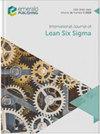使用乐高®汽车装配线的混合模拟模型评估从大规模生产到精益制造的过渡
IF 3.7
2区 工程技术
Q2 ENGINEERING, INDUSTRIAL
引用次数: 1
摘要
目的随着混合仿真技术在多个领域的系统改进中越来越流行,本研究旨在深入了解使用混合仿真来评估精益制造(LM)技术对制造设施的影响,以及大规模生产(MP)设施向结合LM技术的过渡。设计/方法论/方法在本文中,作者应用混合仿真方法来改进教育性汽车装配线,并为实施不同的LM技术提供指导。具体而言,作者描述了乐高®汽车装配线混合离散事件和基于代理的模拟模型的设计、开发、验证和验证,以分析、改进和评估系统性能。模拟方法检查了基础模型(MP)和替代场景(与Heijunka的即时[JIT])。发现混合模拟方法有效地对设施进行了建模。替代模拟场景(实现JIT和Heijunka LM技术)改进了所有检查的性能指标。更详细地说,该系统的交付周期减少了47.37%,吞吐量增加了5.99%,工作站的在建工作减少了56.73%。独创性/价值这种新型的混合模拟方法提供了洞察力,并可用于对其他制造设施进行建模,评估从MP到LM的过渡场景。本文章由计算机程序翻译,如有差异,请以英文原文为准。
Assessing the transition from mass production to lean manufacturing using a hybrid simulation model of a LEGO® automotive assembly line
Purpose
With hybrid simulation techniques getting popular for systems improvement in multiple fields, this study aims to provide insight on the use of hybrid simulation to assess the effect of lean manufacturing (LM) techniques on manufacturing facilities and the transition of a mass production (MP) facility to incorporating LM techniques.
Design/methodology/approach
In this paper, the authors apply a hybrid simulation approach to improve an educational automotive assembly line and provide guidelines for implementing different LM techniques. Specifically, the authors describe the design, development, verification and validation of a hybrid discrete-event and agent-based simulation model of a LEGO® car assembly line to analyze, improve and assess the system’s performance. The simulation approach examines the base model (MP) and an alternative scenario (just-in-time [JIT] with Heijunka).
Findings
The hybrid simulation approach effectively models the facility. The alternative simulation scenario (implementing JIT and Heijunka LM techniques) improved all examined performance metrics. In more detail, the system’s lead time was reduced by 47.37%, the throughput increased by 5.99% and the work-in-progress for workstations decreased by up to 56.73%.
Originality/value
This novel hybrid simulation approach provides insight and can be potentially extrapolated to model other manufacturing facilities and evaluate transition scenarios from MP to LM.
求助全文
通过发布文献求助,成功后即可免费获取论文全文。
去求助
来源期刊

International Journal of Lean Six Sigma
Engineering-Industrial and Manufacturing Engineering
CiteScore
8.90
自引率
15.00%
发文量
46
期刊介绍:
Launched in 2010, International Journal of Lean Six Sigma publishes original, empirical and review papers, case studies and theoretical frameworks or models related to Lean and Six Sigma methodologies. High quality submissions are sought from academics, researchers, practitioners and leading management consultants from around the world. Research, case studies and examples can be cited from manufacturing, service and public sectors. This includes manufacturing, health, financial services, local government, education, professional services, IT Services, transport, etc.
 求助内容:
求助内容: 应助结果提醒方式:
应助结果提醒方式:


